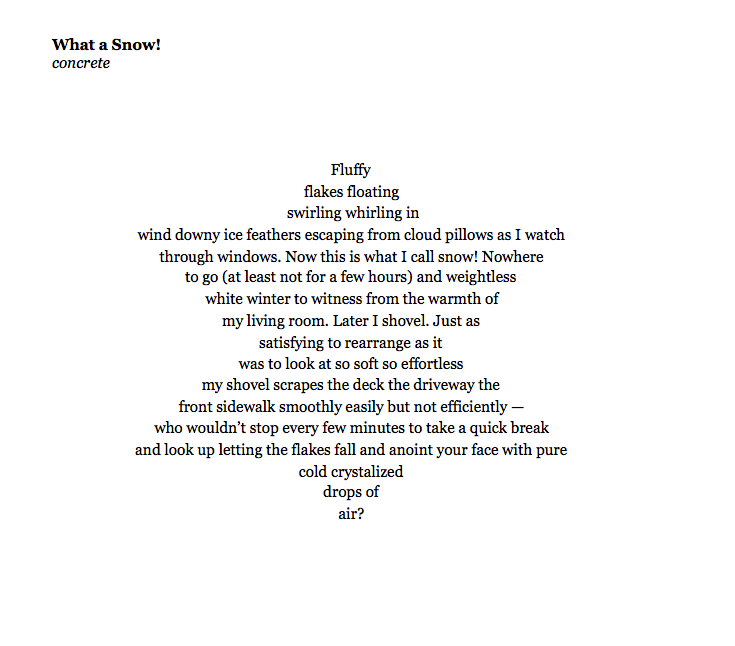29 degrees
70% snow-covered
franklin hill turn around + extra
Snowing this morning on the first day of spring. A wet heavy snow that will soon melt. Decided to run slow and keep going past the bottom of the hills and toward the Bohemian Flats. A nice run. Gray. Humid. A little windy with snow in my face most of the time. Will this be the last snow of the season? Probably not. Speaking of snow, yesterday I turned one of my early morning poetry fragments into a concrete poem:

What do I remember from my run? I thought a lot about keeping my pace relaxed and wondering whether or not my knee would start hurting. Also wondered which direction the wind was blowing–would it be in my face even more when I turned around and ran back home (yes)? Noticed the river flowing down in the flats–a graying brownish blue. The snow wasn’t too slippery, even under the bridge. It also wasn’t crunchy–at least I don’t think it was crunchy–I had headphones on. I was able to run on the walking path–instead of the bike path–for most of my run.
I wanted to start thinking about the differences between walking and running, but I forgot. I started thinking about running and walking last year–I even gathered together some resources and wrote a few creative essays. With spring coming and a desire to be outside more, it seems fitting to walk more and then think about how walking differs from running. A few days ago, I stumbled upon a brief essay about running and how it differs from walking:
But the act of running gives me something I cannot get from a walk, and that is total mental freedom. I agree with Kierkegaard that walking is objectively better than sitting, in terms of feeling good. But it is not always sufficient. And although the day-to-day business of writing is closely connected to walking, the business of being a functioning person – for me – requires something else. Running demands that you concentrate on something which requires almost no conscious thought at all. It is a particular kind of thinking which is all about the next few seconds and entirely pragmatic: mind that low-hanging branch, is that dog on an extendable lead, am I about to get mugged by a flock of Canada geese (the nightclub bouncers of the bird world). It also proves that you are more, or at least other, than you think.
Stepping Up to the Page / Natalie Haynes
I like her idea of running as offering a particular kind of thinking and I agree that much of running time is taken up with mundane, immediate thoughts about branches or cracks in the pavement or how deep a puddle is, whether or not the runner I’m approaching will move over, etc.. But, what I also like about running is that flashes of insight happen too–I have really great thoughts. Because of the effort I’m making and my need to pay attention to my surroundings, I can’t ruminate slowly and obsessively about those thoughts. The best I can do is try to record them in a voice memo or write them in a log entry after I’m done. Why is this a good thing? I’m not sure that I can express it right now–maybe something about a need to correct my tendency to overthink things or my love of imposing limits on my creative process?
